Hello friends,
I was just thinking the other day about a nice question that could spark some interesting/fun discussion for all of us.
What is your favorite non-sword weapon? Why did you pick this weapon?
While that may seem a little simple, let me expound a bit. Consider answer some or all of these questions below:
1) Is there a single style that most draws your attention? If so then why?
2) If given the chance to use this in history, what time/place would you choose?
3) Are there manuscripts out there that illustrate the use of this weapon and have you studied them?
4) Do you own one such weapon? Who made it and what do you love best about it?
I have my own response prepared, but would like to see what some of you say before I post it.
Don't forget that a picture is worth a thousand words.
Spear! I could have said the same even if you had asked about favourite weapon, swords included.
There is an immense variety within the category of "spear", so it's possible to find the "just right" spear. There are simple ones, pretty ones, cheap ones, expensive ones, blingy ones, short ones, long ones, cavalry ones, infantry ones.
Perhaps "spear" is too broad an answer (almost as broad as "sword" would be to a similar question not excluding swords). So, to be more specific: 6-8 foot two-handed cut-thrust spear.
This is about the best spear to use one-on-one, or one-on-few. My opinion, but also what many sources say. It's a very elegant and very effective martial arts weapon. This is the key attraction. It is lots of fun to fight with.
We have European, Chinese, Japanese, and Korean sources on the use of such spears. I've been mostly looking at the Chinese sources. If time permits, I'd like to do a comparison across sources from the different areas. I should find and read some Arab/Mamluk/Turkish/Persian and Indian sources.
For spears in general, I have a bunch of reproductions and antiques, mostly unmounted heads. For this particular type, 6 mounted ones, not counting trainers. 3 Japanese, 2 Viking, 1 Napoleonic. I don't have a particular favourite all-round one. The prettiest is the Hanwei Yari, but I'm not convinced by its balance.
(I will not be surprised if there are many modern firearm replies. Clearly, these are more effective, but not what I would consider as much fun to train with.)
There is an immense variety within the category of "spear", so it's possible to find the "just right" spear. There are simple ones, pretty ones, cheap ones, expensive ones, blingy ones, short ones, long ones, cavalry ones, infantry ones.
Perhaps "spear" is too broad an answer (almost as broad as "sword" would be to a similar question not excluding swords). So, to be more specific: 6-8 foot two-handed cut-thrust spear.
This is about the best spear to use one-on-one, or one-on-few. My opinion, but also what many sources say. It's a very elegant and very effective martial arts weapon. This is the key attraction. It is lots of fun to fight with.
We have European, Chinese, Japanese, and Korean sources on the use of such spears. I've been mostly looking at the Chinese sources. If time permits, I'd like to do a comparison across sources from the different areas. I should find and read some Arab/Mamluk/Turkish/Persian and Indian sources.
For spears in general, I have a bunch of reproductions and antiques, mostly unmounted heads. For this particular type, 6 mounted ones, not counting trainers. 3 Japanese, 2 Viking, 1 Napoleonic. I don't have a particular favourite all-round one. The prettiest is the Hanwei Yari, but I'm not convinced by its balance.
(I will not be surprised if there are many modern firearm replies. Clearly, these are more effective, but not what I would consider as much fun to train with.)
i go along with Timo, its spear !
in particular the ahlspiess (=awl pike ?)
i dont know if there was a specific style of fencing with these (and if there are any manuscripts), but from its looks the use seems to be all about lines and angles. just like rapiers and i absolutely fancy rapiers, maybe thats why i like the ahlspiess.
also in this category of spears, that imho allow for quick fencing are all these with a possibility to parry like the boar spear or the swedish "spears made of swords" (you probably know the dolnstein-depiction).
 Attachment: 56.46 KB
Attachment: 56.46 KB
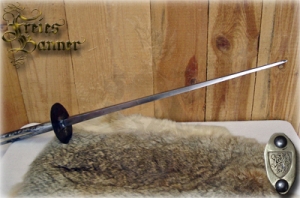
ahlspiess
 Attachment: 33.01 KB
Attachment: 33.01 KB
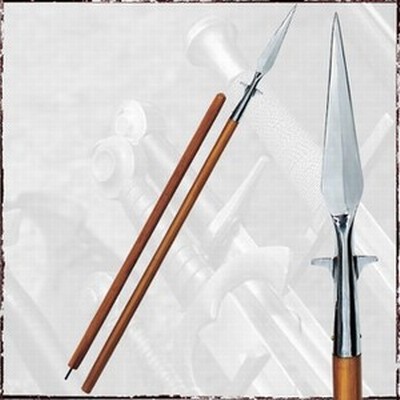
boar spear
in particular the ahlspiess (=awl pike ?)
i dont know if there was a specific style of fencing with these (and if there are any manuscripts), but from its looks the use seems to be all about lines and angles. just like rapiers and i absolutely fancy rapiers, maybe thats why i like the ahlspiess.
also in this category of spears, that imho allow for quick fencing are all these with a possibility to parry like the boar spear or the swedish "spears made of swords" (you probably know the dolnstein-depiction).

ahlspiess

boar spear
I like the Chinese Monks Spade...there are books,manuscripts,DVD's,etc on how to use these but I have no idea on how to personally wield one .They have always seemed like a deadly weapon.And I have enjoyed seeing them in action since growing up watching Shaw Bros. classics.
Generically, I would say the axe. More specifically, I am in love with both one and two handed axes of Viking age northern europe. A good axe can kill a foe, chop down a tree, split the wood, hew the wood into planks or carve it, skin and clean an animal and prep the meat. They use less metal than a sword and if it takes a tapered handle rather than a wedged one, replacing the haft is ridiculously easy. I would go so far as to say that it is probably one of the most (if not the most) versatile tools going - particularly at the time.
[ Linked Image ]
[ Linked Image ]
These are both axes from the site of Ragnar's Ragweed Forge. I don't own either but I want both!
[ Linked Image ]
Just in case you aren't impressed. This is from oldjimbo.com in the survival section. Lots of good axe stuff there. This was done by cutting wedges with the hatchet, starting splits with the hatchet and driving it home with the wedges. A good axe is only limited by your experience and determination.
Beyond general-purpose use, axes like the Kent pattern are fantastic dedicated wood working axes. Unfortunately mine is across the pond with my sister.
I'm not familiar with their use in war, nor am I familiar with any manuscripts instructing such use. I think that in the hand-axe form it would function best in the first millenium AD and earlier; after that and I think armor would get too effective, though I may be wrong. I'm not sure how a two-hander does against plate or mail.
[ Linked Image ]
[ Linked Image ]
These are both axes from the site of Ragnar's Ragweed Forge. I don't own either but I want both!
[ Linked Image ]
Just in case you aren't impressed. This is from oldjimbo.com in the survival section. Lots of good axe stuff there. This was done by cutting wedges with the hatchet, starting splits with the hatchet and driving it home with the wedges. A good axe is only limited by your experience and determination.
Beyond general-purpose use, axes like the Kent pattern are fantastic dedicated wood working axes. Unfortunately mine is across the pond with my sister.
I'm not familiar with their use in war, nor am I familiar with any manuscripts instructing such use. I think that in the hand-axe form it would function best in the first millenium AD and earlier; after that and I think armor would get too effective, though I may be wrong. I'm not sure how a two-hander does against plate or mail.
Peter agree ( Note against armor think Robert the Bruce. )
Without a doubt a Warhammer, aka "tin can opener." There is nothing quite like having a hammer on one side and an armour piercing spike on the other to render your enemy helpless.
For me it would be a War Hammer and probably this one by Arms & Armor http://armor.com/pole005.html
As for my reasons, its hard to say, Ive never handelled one nor have I even seen one in person but I guess for me its just one of those weapons that invokes an emotional response from me. But alas, whilst there is an exemption for collecting swords I fear a war hammer is illegal to own here in Victoria Australia.
As for my reasons, its hard to say, Ive never handelled one nor have I even seen one in person but I guess for me its just one of those weapons that invokes an emotional response from me. But alas, whilst there is an exemption for collecting swords I fear a war hammer is illegal to own here in Victoria Australia.
Probably it would be a seax, and more specifically, an Anglo-Saxon boken-back seax.
Well, the general answer is polearm:
A) Basic spear/Winged spear for simplicity and speed.
B) Bill/Halberd versatility.
C) Poleaxe/Pole-Hammer, will make an " impression " no matter how well armoured is the opponent.
D) Long handled Danish Axe/Bardiche, well it's an axe. :lol:
The main issue is length: Short polearms 5' to 6' for closer in fighting versus the 7' to 9' ones with more reach but still handy for one on one fighting.
The really long ones for formation fighting.
If only one choice the Halberd or Bill wins for me. ( A&A semi-custom Bill in pic )
 Attachment: 85.42 KB
Attachment: 85.42 KB
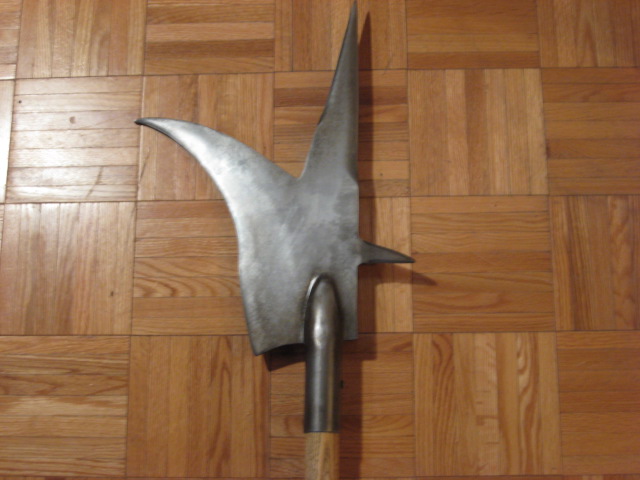
Stab, slash, chop, hook, parry, draw/push cuts, Butt strokes ... etc
A) Basic spear/Winged spear for simplicity and speed.
B) Bill/Halberd versatility.
C) Poleaxe/Pole-Hammer, will make an " impression " no matter how well armoured is the opponent.
D) Long handled Danish Axe/Bardiche, well it's an axe. :lol:
The main issue is length: Short polearms 5' to 6' for closer in fighting versus the 7' to 9' ones with more reach but still handy for one on one fighting.
The really long ones for formation fighting.
If only one choice the Halberd or Bill wins for me. ( A&A semi-custom Bill in pic )

Stab, slash, chop, hook, parry, draw/push cuts, Butt strokes ... etc
It has to be the spear, especially the lance.
 Attachment: 67.61 KB
Attachment: 67.61 KB
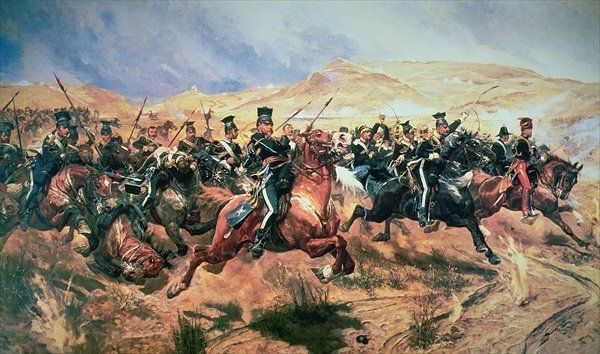

I would have to say the quarterstaff. It is a simple yet effective weapon that can draw from a large host of material, both European and Asian. It can also effectively use longsword, polearm, and spear maneuvers without too much adaptation. It is useable against a wide variety of protective equipment; while it may not be lethal in all cases, it will certainly be able to defeat your opponent.
You can take it anywhere, since few places in antiquity and modern times recognize it as a weapon. It has the utilitarian purpose of a walking stick. To top off the argument, one can carve one himself with minimal effort. I make a few every year, out of some black locust (and occasionally oak) trees on my father's and grandfather's farm.
You can take it anywhere, since few places in antiquity and modern times recognize it as a weapon. It has the utilitarian purpose of a walking stick. To top off the argument, one can carve one himself with minimal effort. I make a few every year, out of some black locust (and occasionally oak) trees on my father's and grandfather's farm.
I dabble about with non sword items. Spears seem to have a fascination for me, as do halberds. There is a cheapie German halberd head out there that I may work into a shape mrmore like the British sergeants halberds of the 18th century.
http://www.kultofathena.com/product.asp?item=...lberd+Head
I am having a Goldilocks moment with my hanwei spontoon and after hafting it twice (for length) willl probably have a third go this season. I picked up a Friedrich spear here at myArmoury and found some more background on the original being half again as big. I picked up an A&A Nordlund on the sly as well but have always had an eye on their Hungarian. This while having hefted their Dane a couple of times in the past. Axes always seem more utilitarian to me, as having used them for so many decades. One return to youth was finding a Collins camp/cruising size axe and another fairly scarce ames ice axe from the WWII period. I actually used the Nordland to cut a path past a downed tree's branches in that freak October snow last fall. The Friedrich has robbed the spear budget plans but the Hanwei yaris look like something I really need. Or a Kris Cutlery yari blade, hafted to suit.
The Ames ice axe could sure do the job as a weapon as well and I have used it to chip out ice off the roof and drifts from a last season.. A mild winter this year. These were Mountain Division army pieces.
http://www.alpenglow.org/ski-history/notes/book/burton-1971.html
Cheers
GC
 Attachment: 26.28 KB
Attachment: 26.28 KB
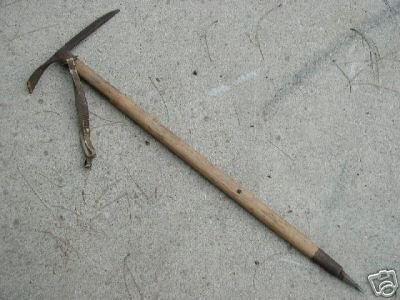
 Attachment: 36.93 KB
Attachment: 36.93 KB
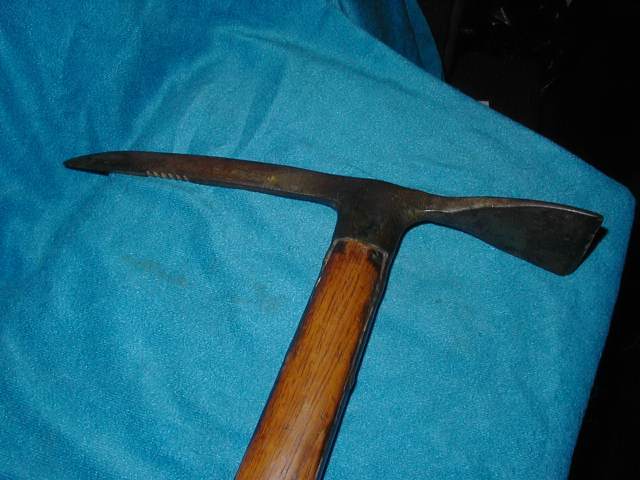
 Attachment: 42.17 KB
Attachment: 42.17 KB
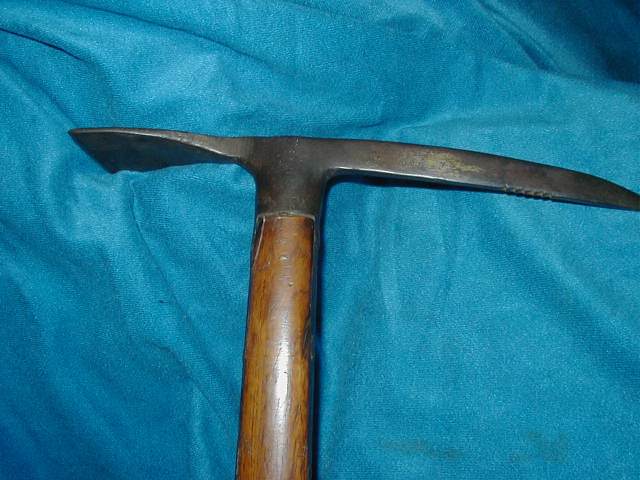
 Attachment: 104.15 KB
Attachment: 104.15 KB

http://www.kultofathena.com/product.asp?item=...lberd+Head
I am having a Goldilocks moment with my hanwei spontoon and after hafting it twice (for length) willl probably have a third go this season. I picked up a Friedrich spear here at myArmoury and found some more background on the original being half again as big. I picked up an A&A Nordlund on the sly as well but have always had an eye on their Hungarian. This while having hefted their Dane a couple of times in the past. Axes always seem more utilitarian to me, as having used them for so many decades. One return to youth was finding a Collins camp/cruising size axe and another fairly scarce ames ice axe from the WWII period. I actually used the Nordland to cut a path past a downed tree's branches in that freak October snow last fall. The Friedrich has robbed the spear budget plans but the Hanwei yaris look like something I really need. Or a Kris Cutlery yari blade, hafted to suit.
The Ames ice axe could sure do the job as a weapon as well and I have used it to chip out ice off the roof and drifts from a last season.. A mild winter this year. These were Mountain Division army pieces.
http://www.alpenglow.org/ski-history/notes/book/burton-1971.html
Cheers
GC




It's a toss up between a bow and a staff. I love archery for many of the same reasons that I love fencing, but the staff is an amazingly practical thing whether on a hike or in a fight.
| Sam Barris wrote: |
| It's a toss up between a bow and a staff. I love archery for many of the same reasons that I love fencing, but the staff is an amazingly practical thing whether on a hike or in a fight. |
Luke Kramer wrote:
| Quote: |
| I would have to say the quarterstaff. It is a simple yet effective weapon that can draw from a large host of material, both European and Asian. It can also effectively use longsword, polearm, and spear maneuvers without too much adaptation. It is useable against a wide variety of protective equipment; while it may not be lethal in all cases, it will certainly be able to defeat your opponent.
You can take it anywhere, since few places in antiquity and modern times recognize it as a weapon. It has the utilitarian purpose of a walking stick. To top off the argument, one can carve one himself with minimal effort. I make a few every year, out of some black locust (and occasionally oak) trees on my father's and grandfather's farm. |
Yes to the staff, for all the reasons mentioned in Luke's post a few comments above this one, as I like use and make walking sticks for myself and have taken lessons in " Quarterstaff " as well as 4 years of longsword. ( A lot of longsword techniques are applicable to the short staff using the same basic principles + having two ends to do them with giving even more versatility ).
Now, in period combat I think I would still favour the English Bill as more lethal, but the staff being light can be faster than any other pole arm, and with superior skills, one can outtime an opponent with a heavier and bladed polearm.
For a period staff I would add steel end caps or blunt short spikes to each end for a little extra punch and to protect the ends when using it as a walking staff.
By the way just returned from the Gym where I did some solo practice with my new 56" Macassar Ebony walking staff and walked back the one mile from the Gym to my home. ( Pics of that one soon in it's own Topic ).
Once one gets used to carrying one, a long walking stick or a short staff is very good for very long walks and gives one's steps a nice rhythm and some forward propulsion for a fast power walk.
Sam, If the bow is a long and heavy longbow it might be usable as a staff in an emergency, and if one has run out of arrows, although one might not want to risk damaging a good bow, an emergency is an emergency. ;) :D
Well, it would be two weapons and sort of " cheating " in the context of this Topic but I would carry a bow ( Arrows would be nice to have also. ;) ;) :D ) and carry a spear with a pointy Butt Spike so I could plant the spear in the ground next to me any time I need to shoot the bow and be able to quickly grab the spear to run away or fight if the danger came up close.
I find the mace to be a very interesting weapon. Apparently the mace was also a common monk's weapon due to the fact it wouldn't draw blood (for some reason crushing bones isn't a sin :p).
I think its a very underappreciated weapon, especially in film. The stereotypical knight's weapon is a sword or an axe. Flanged maces deliver powerful, denting holes, much like spiked maces, while flails (based off the agricultural device) gain their momentum from its own weight until finally cracked. The mace is also a common cerimonial weapon. The only real disadvantage is that you can't defend with it.
I'm not sure how accurate flailed maces are in a medieval Britain setting, but whether they existed or not doesn't matter, they're a very cool weapon because of their simplicity and uniqueness.
I always imagined the best way to take down an armoured knight was a shield to block his sword and then bash him to the ground with a heavy mace to disable him.
If I had to choose one weapon to have other than a sword it would be a flail.
I think its a very underappreciated weapon, especially in film. The stereotypical knight's weapon is a sword or an axe. Flanged maces deliver powerful, denting holes, much like spiked maces, while flails (based off the agricultural device) gain their momentum from its own weight until finally cracked. The mace is also a common cerimonial weapon. The only real disadvantage is that you can't defend with it.
I'm not sure how accurate flailed maces are in a medieval Britain setting, but whether they existed or not doesn't matter, they're a very cool weapon because of their simplicity and uniqueness.
I always imagined the best way to take down an armoured knight was a shield to block his sword and then bash him to the ground with a heavy mace to disable him.
If I had to choose one weapon to have other than a sword it would be a flail.
| Dave Stephan wrote: |
| I find the mace to be a very interesting weapon. As I'm sure a lot of you know a plain mace was also a common monk's weapon due to the fact it wouldn't draw blood (for some reason crushing bones isn't a sin :p).
The only real disadvantage is that you can't defend with it. |
The whole priest and Monks thing about not drawing blood seems to be mostly a literary fabrication or speculative Victorian notion that has little to no period supporting evidence. ( Not a criticism of your post, just bringing up what I've read commented on this site before that more recent scholarship hold a different opinion than earlier sources of the late 19th century and early 20th: I used to believe the same thing. :cool: ).
As to defensive use of the mace it may well be difficult or impossible to defend quickly enough with it when held in one hand but one can hold it with one hand near the head and one near the butt end and use it to block as a short staff or bäton and transition to one hand for committed attacks, quickly reverting to two handed use. Now, if used with a shield the situation changes. ;)
My A&A Spiked mace for example or their High Gothic Mace both have very solid steel handles than could block just about anything and in close quarters one could trust with the mace using the top spike in the case of the Spiked Mace or the top end of the Gothic mace.
One could do the same with their ( Or any other of the same design ) " Warhammer but the wooden handle might be more easily damaged.
http://www.arms-n-armor.com/pole004.html
http://www.arms-n-armor.com/pole193.html
http://www.arms-n-armor.com/pole005.html
| Quote: |
| The whole priest and Monks thing about not drawing blood seems to be mostly a literary fabrication or speculative Victorian notion that has little to no period supporting evidence. |
You mean like when they said knights fought dragons and rescued damsels from Disney-esque towers by kissing them? Those Victorians. :mad:
When I read wikipedia and saw that the internets said it was only a rumour I jumped to change my decree to 'apparently' but you quoted it before I could do so. :lol: No offense taken either, correct me anytime I make a mistake because I'd rather know the truth and have my feelings shattered like a knight after being hit with a mace. :cry: Still it is an interesting idea, but when you look at it I don't see any reason why they wouldn't want to draw blood over breaking bones. Tomayto tomarto.
The mace is a great weapon offensively, but it's a shame it can't be a defensive weapon too. Perhaps if a crossbar was installed much like the hilt of a sword, that way any opposing weapon could be hooked and taken out of the way giving you room to bash them. Obviously a mace user would need a shield to make up for the loss of manouverability and defense.
| Dave Stephan wrote: |
|
I think its a very underappreciated weapon, especially in film. The stereotypical knight's weapon is a sword or an axe. Flanged maces deliver powerful, denting holes, much like spiked maces, while flails (based off the agricultural device) gain their momentum from its own weight until finally cracked. The mace is also a common cerimonial weapon. The only real disadvantage is that you can't defend with it. |
A mace is under-used in film, while the spiked ball flail is rather overdone.
So many maces are quite light, and short, I don't see them as "powerful". Certainly effective on unarmoured opponents, or lightly armoured. Against good armour? Maybe not all maces are anti-armour weapons! Cheap - don't need good steel to make one - and almost indestructable, the ideal sidearm to carry for use when your lance, bow, and sword are all broken ("bow", because the mace was a common Mongol sidearm).
You can certainly defend with a mace. One of the best bits of live (simulated) combat I ever saw was two-handed mace against various weapons. Superb defence by the mace-wielder, easily making up for the lack of reach, letting him get in close and defeat his opponents. Don't need a crossbar/guard for defensive use of a weapon.
Mace is nice enough to use, if you're prepared to deal with the lack of reach. Using one too much makes my sword technique deteriorate, because with mace no attention to edge alignment is needed.
A two handed mace certainly, you could use it like a quarterstaff to take blows plus the added feature of a longer grip, thus more momentum when you swing it, more power. Two hands = more power on the swing too.
However using a one handed mace or a flail would require a shield because I don't see how you can defend using a single handed mace, especially if its weighty. You lose a lot of power without the extra length and hand. I myself have never seen a flail used in film, except during the fight scene of Ivanhoe (1953). Maybe I have and don't remember.
A flail would require a lot more skill than a mace as well because of the unpredictabiltiy of the moving head. You have to keep it powered or else you're vulnerable but you have to keep it away from you as well. If you can use a flail and a shield together and sustain the speed you're flying.
However using a one handed mace or a flail would require a shield because I don't see how you can defend using a single handed mace, especially if its weighty. You lose a lot of power without the extra length and hand. I myself have never seen a flail used in film, except during the fight scene of Ivanhoe (1953). Maybe I have and don't remember.
A flail would require a lot more skill than a mace as well because of the unpredictabiltiy of the moving head. You have to keep it powered or else you're vulnerable but you have to keep it away from you as well. If you can use a flail and a shield together and sustain the speed you're flying.
Page 1 of 4
You cannot post new topics in this forumYou cannot reply to topics in this forum
You cannot edit your posts in this forum
You cannot delete your posts in this forum
You cannot vote in polls in this forum
You cannot attach files in this forum
You can download files in this forum
All contents © Copyright 2003-2006 myArmoury.com — All rights reserved
Discussion forums powered by phpBB © The phpBB Group
Switch to the Full-featured Version of the forum
Discussion forums powered by phpBB © The phpBB Group
Switch to the Full-featured Version of the forum